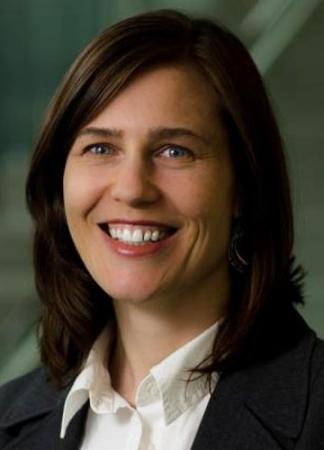
Assistant Professor of Engineering
The mantra among cardiologists is "time is muscle." Quick treatment is essential during a heart attack because damaged heart muscle is replaced by scar tissue, and scar tissue lacks the ability to contract and pump blood like healthy heart tissue. The loss of function is permanent. There are currently no therapies that can repair heart tissue at the cellular level.
Kareen Coulombe is trying to change that.
Coulombe, assistant professor of engineering, is using stem cells to engineer tissue with similar contractile function as healthy heart tissue. The ultimate goal of the work is "to create a cell-based implant on the tissue level that can restore cardiac function," she said.
Coulombe's interest in the heart is longstanding. Her undergraduate thesis dealt with the embryonic development of the heart, and she did heart-related research while earning her Ph.D. in bioengineering at the University of Washington.
"When you come from a mechanical perspective, it's a fascinating organ," she said. "It's really just a pump, but it has a very intricate geometry that makes it one of the most efficient pumps that exists. It's constantly working, so it doesn't fatigue. It has electrical signaling as well as mechanical components that are all very important. I just love the physiology of it."
Before therapies to regenerate heart tissue can become a therapeutic reality, there are many and varied problems that need to be solved. "It's a great mix of basic and applied science," Coulombe said. She has been making steady progress on those problems for the last five years during postdoctoral research at the University of Washington, supported by the National Institutes of Health.
The first problem is directing stem cells to reliably differentiate into contractile heart cells, called cardiomyocytes. Stem cells are the Swiss Army Knives of human cells. Add the right cocktail of chemicals and they can differentiate into any cell type in the body, from hair to heart cells. "The protocols have been getting a lot better in recent years," Coulombe said. "We can reliably get over 50 percent of our cultures to be cardiomyocytes and as high as 90 to 95 percent cardiomyocytes."
Just over a week into the differentiation process, something rather incredible happens. "After about 10 to 12 days," Coulombe said, "you see spontaneous beating of these cells in the dish."
Harnessing that contractile power — essential to the heart's ability to pump blood — is central to Coulombe's work. Currently, the contractile strength of the stem cell-derived cardiomyocytes can't quite match the power of mature cardiomyocytes. "What I've been trying to do recently — and I'll continue at Brown — is try to stimulate growth pathways so that the stem-cell derived cardiomyocytes produce more contractile strength and therefore get closer to what I think is going to be an effective therapeutic," she said.
To that end, Coulombe is working to culture cells in systems that more closely resemble the environment in which cells grow in the body. One promising approach is culturing cells in three-dimensional molds with natural extracellular matrix as a scaffold, rather than on traditional two-dimensional films. Preliminary evidence suggests that 3-D cultures lead to the development of more mature cells.
However, culturing healthy, mature cells is only half the battle. Coulombe is also working to find the best ways to implant these cells in a working heart. To survive, the tissue needs to grow vessels that supply it with blood. It also needs to integrate electromechanically, so that it beats in time with native tissue. Coulombe is working on both of those problems.
"One of the things that I want to continue to work on is how to encourage the host to grow into the tissue," she said. "I'm developing ways to deliver growth factors through the engineered tissue that encourage angiogenic growth and vessel sprouting into the tissue."
In addition to her research, Coulombe is also looking forward to the opportunity to work with Brown students.
"I really value a rich education and that's something Brown provides its students," she said. "I feel like that's something that I can commit to 100 percent."
In other words, it's something she can approach with her whole heart.
- by Kevin Stacey